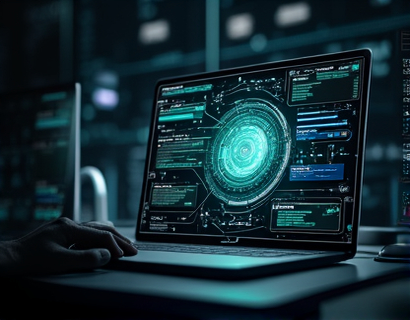Blockchain-Powered Notarization: Revolutionizing Document Security and Accessibility with Decentralized Trust
In an era where digital transformation is reshaping industries, the notarization process has seen a significant shift with the advent of blockchain technology. Blockchain-powered notarization is redefining document security and accessibility, offering legal professionals and businesses a seamless, efficient, and transparent process. This innovative service leverages the inherent properties of blockchain to ensure document integrity and authenticity through decentralized trust, providing enhanced security and trustworthiness.
The traditional notarization process, while crucial for validating the authenticity of documents, often involves cumbersome paper-based procedures, lengthy wait times, and a reliance on centralized authorities. These challenges have led to a growing need for a more modern, digital approach that can streamline the process without compromising on security or legitimacy. Blockchain technology emerges as an ideal solution, offering a decentralized and immutable ledger that can revolutionize how documents are notarized and verified.
Understanding Blockchain Technology in Notarization
Blockchain, at its core, is a distributed ledger technology that records transactions across multiple computers in such a way that the registered transactions cannot be altered retroactively. This characteristic makes blockchain highly suitable for notarization, where the integrity and immutability of documents are paramount. Each block in the chain contains a cryptographic hash of the previous block, a timestamp, and transaction data, creating a secure and transparent chain of custody for documents.
The decentralized nature of blockchain eliminates the need for a central authority, reducing the risk of single points of failure and enhancing security. In the context of notarization, this means that once a document is notarized on the blockchain, it becomes nearly impossible to tamper with or alter without detection. This level of security is achieved through advanced cryptographic techniques and consensus mechanisms that ensure all participants in the network agree on the state of the ledger.
Enhanced Document Security
One of the most significant advantages of blockchain-powered notarization is the enhanced security it provides. Traditional notarization relies on physical documents and manual verification processes, which are vulnerable to forgery, loss, and unauthorized access. In contrast, blockchain ensures that once a document is notarized, it is stored in a secure, tamper-evident format. Each notarization event is recorded as a transaction on the blockchain, creating an unalterable record that can be verified by anyone with access to the network.
The use of cryptographic hashes and digital signatures further fortifies the security of documents on the blockchain. A document's hash, a unique digital fingerprint, is created and stored along with the notarization record. Any attempt to modify the document, even slightly, would change its hash, immediately alerting all network participants to the tampering. This ensures that the document remains intact and authentic throughout its lifecycle.
Moreover, blockchain's inherent transparency allows all stakeholders to track the history and status of a document in real-time. This level of visibility not only enhances trust but also reduces the risk of disputes and fraud. Legal professionals and businesses can confidently rely on the authenticity and integrity of documents, knowing that they are protected by robust cryptographic measures.
Improved Accessibility and Efficiency
Blockchain-powered notarization significantly improves the accessibility and efficiency of the notarization process. Traditional methods often require physical presence, lengthy submission and review periods, and coordination with multiple parties. In contrast, blockchain-based notarization can be conducted entirely online, allowing documents to be notarized and verified from anywhere in the world with an internet connection.
The process begins with the creation of a digital document, which is then submitted to a blockchain network for notarization. A notary, acting as a trusted entity on the network, verifies the document's authenticity and signs it digitally. This digital signature, combined with the cryptographic hash, creates a binding and verifiable record of the notarization event. The entire process, from submission to notarization, can be completed in a matter of minutes, drastically reducing the time and effort required compared to traditional methods.
Furthermore, the decentralized nature of blockchain enables multiple notaries to operate on the same network, increasing capacity and reducing bottlenecks. This scalability ensures that even during peak usage periods, the notarization process remains efficient and reliable. Businesses and legal professionals can thus streamline their workflows, reducing delays and improving overall productivity.
Decentralized Trust and Reduced Costs
One of the most transformative aspects of blockchain-powered notarization is the establishment of decentralized trust. In a traditional setup, trust is placed in centralized authorities such as government agencies or notary offices. While these entities play a crucial role, they can also become bottlenecks and points of failure. Blockchain eliminates the need for such intermediaries by distributing trust across a network of nodes.
Each participant in the blockchain network, including notaries, clients, and other stakeholders, has a copy of the ledger. This redundancy ensures that no single entity has control over the entire system, reducing the risk of manipulation or corruption. The consensus mechanisms used in blockchain networks, such as Proof of Work or Proof of Stake, further ensure that all transactions are validated by multiple parties, enhancing the overall trustworthiness of the system.
Decentralized trust also translates to cost savings. Traditional notarization often involves fees charged by notary offices and government agencies. Blockchain-powered notarization reduces these costs by eliminating intermediaries and automating many of the manual processes. The use of smart contracts, self-executing contracts with the terms directly written into code, can further streamline transactions, reducing administrative overhead and associated expenses.
Use Cases and Applications
The applications of blockchain-powered notarization are vast and varied, making it a valuable tool across multiple industries. In the legal sector, it can be used to notarize contracts, wills, and other legal documents, ensuring their authenticity and enforceability. For real estate transactions, blockchain can provide a secure and transparent way to notarize property deeds and transfer records, reducing the risk of fraud and disputes.
In the corporate world, blockchain-powered notarization can be employed for shareholder agreements, corporate bylaws, and other critical business documents. This ensures that all stakeholders have access to verified and tamper-proof records, enhancing governance and compliance. Additionally, in the field of intellectual property, blockchain can secure patents, copyrights, and trademarks, providing creators with an immutable record of ownership and creation dates.
Beyond these specific applications, blockchain-powered notarization can also benefit international transactions and cross-border collaborations. The global nature of blockchain ensures that documents notarized in one country can be recognized and verified in another, facilitating seamless international business operations.
Challenges and Considerations
While the benefits of blockchain-powered notarization are clear, there are several challenges and considerations that need to be addressed for widespread adoption. One of the primary challenges is regulatory compliance. Different jurisdictions have varying laws and regulations regarding digital notarization and the use of blockchain technology. Ensuring that blockchain-based notarization solutions comply with local and international regulations is essential for legal validity and acceptance.
Another consideration is the technical expertise required to implement and maintain blockchain systems. Not all legal professionals and businesses may have the necessary knowledge to fully leverage blockchain technology. Education and training programs can help bridge this gap, but initial adoption may require support and guidance from technology providers.
Interoperability is also a key factor. For blockchain-powered notarization to be truly effective, different blockchain platforms and systems need to be able to communicate and share data seamlessly. Standardization efforts and collaboration among industry players are crucial to achieving this goal.
Future Prospects
As blockchain technology continues to mature, the potential for blockchain-powered notarization to transform document security and accessibility is immense. Future developments may include the integration of advanced cryptographic techniques, such as zero-knowledge proofs, to enhance privacy while maintaining transparency. Additionally, the adoption of decentralized identity systems can further streamline the notarization process by providing secure and verifiable identities for all participants.
The increasing awareness of the benefits of blockchain in various sectors is likely to drive more organizations to explore and implement blockchain-powered notarization solutions. As more legal professionals and businesses recognize the value of decentralized trust and enhanced security, the demand for such services is expected to grow, leading to further innovation and improvement in the field.
In conclusion, blockchain-powered notarization represents a significant leap forward in document security and accessibility. By leveraging the unique properties of blockchain, this innovative approach offers a secure, efficient, and transparent alternative to traditional notarization methods. As the technology continues to evolve and gain acceptance, it has the potential to revolutionize how we handle and verify documents in both digital and physical worlds.










































